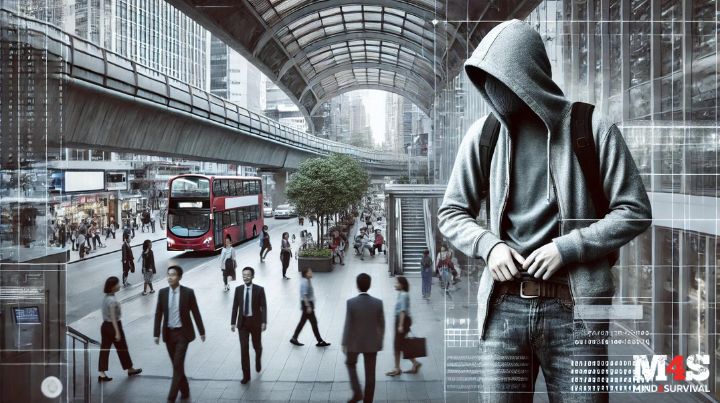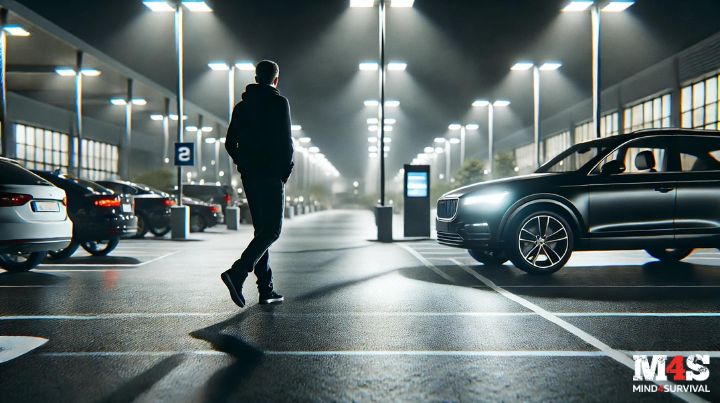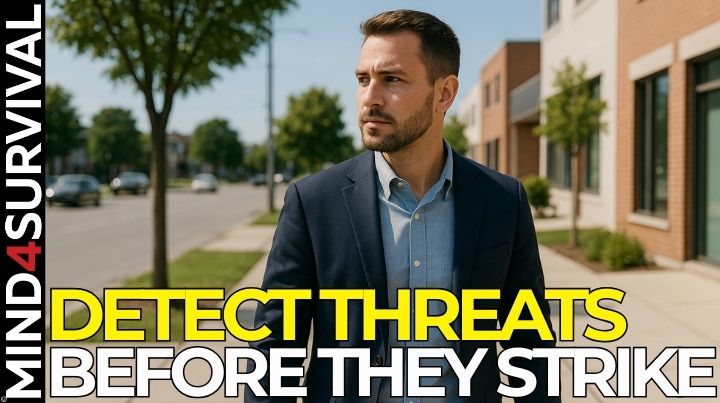How to Spot Trouble Before It Starts: Situational Awareness Tips


Podcast: Play in new window | Download
In our day-to-day lives, situational awareness tips are useful because we often move through familiar places like parking lots, grocery stores, or cafes without considering our surroundings. However, having strong situational awareness can be the difference between staying safe and finding ourselves in risky situations. This article will walk you through how to sharpen your situational awareness in common settings and help you recognize potential dangers before they escalate.
Spotting Someone Who Might Be Trouble
One of the most important aspects of situational awareness is identifying individuals who might pose a threat. Here’s what to look for:
Body Language: Pay attention to how people move. Someone who appears confident and capable might exhibit certain traits—steady movement, a purposeful walk, and relaxed but attentive body posture. However, if they’re scanning the area frequently or pacing, it could be a sign of heightened alertness or even nervousness.
Eye Contact: Too much or too little eye contact can be signs of trouble. A person making constant, intense eye contact might be sizing up their environment or potential targets. On the other hand, someone avoiding eye contact completely may be anxious, trying to hide something, or feeling guilty.
Hands and Movement: Hands tell a story. People who are fidgeting, keeping their hands in their pockets, or frequently touching their waistband might be concealing something. Swift, unnecessary movements towards their pockets or waistband could indicate they’re hiding a weapon or other harmful object.
Clothing Fit: Always pay attention to the fit of a person’s clothes in context with the weather. For instance, a large, bulky jacket in the middle of summer may be used to conceal weapons or other items.
Why It Matters: Spotting these signs quickly allows you to take control of your safety. Whether avoiding the person altogether or leaving the area, noticing these subtle cues gives you valuable time to act before something happens.
Tips to Avoid Trouble: Trust your gut if someone’s behavior feels off. Keep your distance, adjust your path, and avoid direct engagement. Stand tall and walk purposefully to make it clear that you’re not an easy target.

Situational Awareness in Parking Lots
Parking lots are among the most common areas where people let their guard down, yet we’re also the most vulnerable. Here’s how to stay sharp and safe in this environment:
Why Parking Lots Matter: Parking lots are transitional spaces where you’re either entering or exiting an area and often distracted. It’s easy to become focused on loading groceries or finding your keys, which creates opportunities for potential criminals to strike. Whether it’s a carjacking or an opportunistic theft, staying alert in parking lots can significantly reduce your risk.
What to Look For:
- Vehicles with Occupants: Take note if you notice someone sitting in a parked car, especially if they’re not getting in or out. Are they watching other people closely? Do they seem out of place?
- Loitering Individuals: Someone lingering around without a clear purpose could wait for an opportunity to act. This could be a red flag if they seem particularly interested in other people or cars.
- Lighting and Blind Spots: Dark or poorly lit areas, as well as large vehicles or pillars that block your view, can provide cover for potential criminals. Be aware of these areas as you navigate the parking lot.
- Your Distractions: It’s easy to get distracted while handling bags or talking on the phone, but these are the moments when you’re most vulnerable. Keep your head up and your hands-free until you’re safely inside your car.
Why It Matters: Staying alert in parking lots isn’t just about spotting trouble before it happens—it’s about maintaining control of your environment. By staying aware of who and what is around you, you’ll have the time and space to make safer choices, like changing your route or delaying your walk to the car.
Tips for Staying Safe:
- Keep your keys ready before you leave the store so you can quickly unlock and enter your car.
- Walk confidently and scan your surroundings, making sure not to appear distracted by bags or phones.
- If something doesn’t feel right—someone lingering nearby or a car with a watching occupant—don’t hesitate to return to the store and ask for an escort.

Situational Awareness in Other Common Settings
At a Restaurant or Cafe: It's easy to let your guard down when you’re out for a meal or a coffee. But there are simple ways to stay aware without feeling paranoid. Try to sit in a spot where you can see the entrance and most of the room. This allows you to notice who’s coming and going. Also, always make a mental note of the exits—this way, you can quickly leave if something feels off or an emergency occurs.
Public Transportation: Public transit is another place where personal space can become limited, making you feel more vulnerable. Always stay aware of who’s sitting or standing near you. If someone moves into your space unnecessarily or seems overly focused on you, trust your instincts and change your seat or stand in a different area. People who act erratically or appear nervous are also worth watching—these could be early signs of trouble.
In Crowds or Public Events: Monitoring crowd movement in large gatherings, like festivals or concerts, is important. If the crowd starts moving suddenly or you notice people scattering, it could signal a problem ahead. Additionally, stay cautious of small groups acting in coordination—they may work together to create distractions for theft or other criminal activity.
The Bottom Line on Situational Awareness Tips
Situational awareness isn’t about paranoia; it’s about being mindful of your surroundings and making small adjustments to stay safe. Whether in a parking lot, at a cafe, or navigating a crowded event, paying attention to body language, subtle cues, and potential distractions can keep you ahead of trouble. Practice these skills regularly, and staying alert will become second nature.
By staying aware, you can navigate your daily life with greater confidence and control, making your world safer.
Additional Resources
- Situational Awareness: Staying Alert and Staying Safe
- Pet Preparedness; Neighborhood Situational Awareness
- Teaching Situational Awareness to Kids
- Improve Your Situational Awareness
Stay safe,

Related Articles
FREE Guide
Read the Best Seller
Join Mind4Survival
Stay informed by joining the Mind4Survival! 100% Secure! 0% Spam!
Affiliate Disclosure...
Mind4Survival is a free, reader supported information resource. If you make a purchase through our link, we may, at no cost to your, receive an affiliate commission.
Do You Want To Be Ready No Matter What?

Download our free 39-page guide with interactive, 7-Day Emergency Kit Checklist and take the first step toward real preparedness.
- Know exactly where to start.
- Save time and money.
- How-to build a complete Basic Emergency Kit.
- Level up your safety and security.
Join Mind4Survival
Stay informed by joining the Mind4Survival! 100% Secure! 0% Spam!






Central SC here— No power, law enforcement telling people to stay home and not go cruising around.Over 1.3 million households without power in SC.
I have solar security lights around house,put up after the storm came thru. Cleaned debris from front yard..always carrying self protection device.
With the extent of the damage—SE USA,I can see things go downhill….quickly
I’m glad you came through it okay. Stay safe! ~Brian